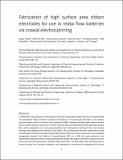Fabrication of high surface area ribbon electrodes for use in redox flow batteries via coaxial electrospinning
Author(s)
Yadav, Shashi; Kok, Matt DR; Forner-Cuenca, Antoni; Tenny, Kevin M; Chiang, Yet-Ming; Brushett, Fikile R; Jervis, Rhodri; Shearing, Paul R; Brett, Dan; Roberts, Edward PL; Gostick, Jeff T; ... Show more Show less
DownloadAccepted version (1.565Mb)
Publisher with Creative Commons License
Publisher with Creative Commons License
Creative Commons Attribution
Terms of use
Metadata
Show full item recordAbstract
© 2020 A method for the preparation of electrospun with fibers possessing a ribbon-like cross-sectional shape was developed. These materials could prove beneficial as flow-through electrodes, since ribbons provide a higher surface-to-volume ratio compared to fibers, thereby providing higher reactive surface area at a given porosity. Fabrication of these materials was accomplished by electrospinning a coaxial fiber with a polystyrene core and polyacrylonitrile shell, followed by leaching of the core material leading to the collapse of the shell into a flat ribbon. The surviving shell was then carbonized to make an electrically conductive and electrochemically reactive fibrous structure. Analysis by x-ray computed tomography showed that ribbons of approximately 400 nm × 800 nm were produced, and experimental characterization revealed that they did indeed offer higher volumetric surface area than previously reported electrospun cylindrical fiber electrodes. The electrodes were characterized for various physical and transport properties and compared to commercial Freudenberg H23 carbon paper in terms of performance in a vanadium redox flow battery. The ribbon-based electrode had better performance and higher power density than commercial Freudenberg H23 electrode in the activation region, though suffered early onset of mass transfer limitations.
Date issued
2021Department
Massachusetts Institute of Technology. Department of Chemical Engineering; Massachusetts Institute of Technology. Department of Materials Science and EngineeringJournal
Journal of Energy Storage
Publisher
Elsevier BV